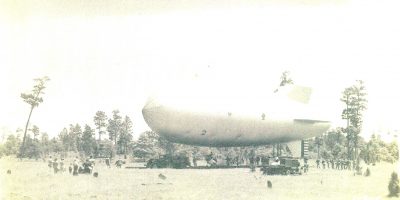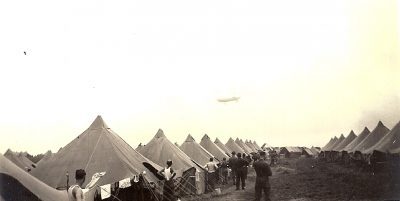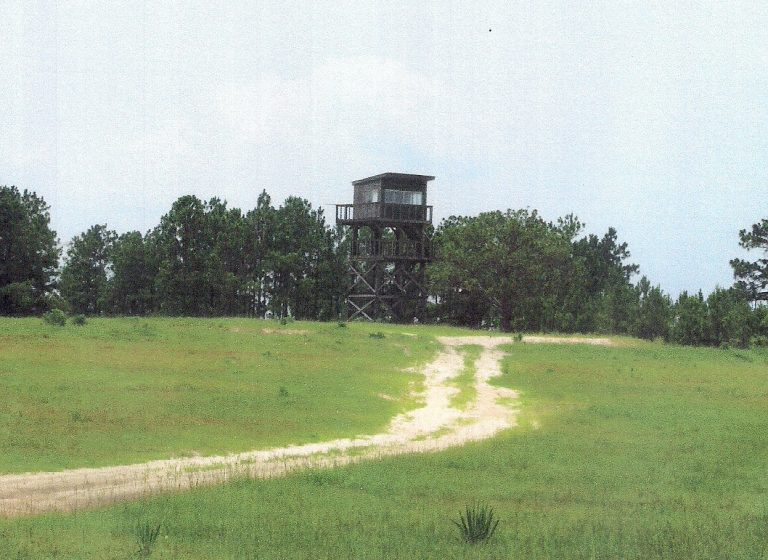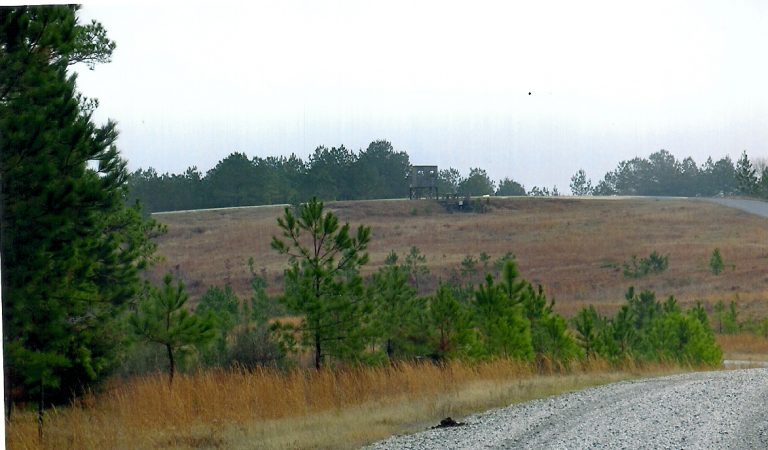Rickey Robertson's Stories from across the Sabine River: Peason, Peason Ridge, and the Southern Confederacy
IT’S A BLIMP!
Throughout the history of warfare, armies have needed to observe the troop movements of the enemy. Every high point was used to try and see any movement of the enemy. Dating back to the Civil War both the Union and Confederate Armies used balloons to look and see if they could see any movement of the opposing forces. The balloons were fitted with a basket and officers with field glasses would be raised high above the battle lines to look for any activity and if seen would drop messages to the handling crew on the ground. These messages would then be carried to the commanding officer so he could plan an attack. But being in the balloon was dangerous due to high winds breaking the ropes that tethered the balloon to the ground but also every observation balloon would be fired upon by sharpshooters. Many were actually shot down after being hit by rifle fire and many crewmen were wounded and killed. By World War I the US Army had a small fleet of balloons used for observation so that commanders could keep an eye on German troop movements and the locations of machine gun bunkers and artillery batteries. But these balloons were different from the Civil War balloons in the fact that they were motorized and could attain very high altitudes. Since they were motorized they could fly over the front lines and come back with up to date intelligence. But in World War I the Germans, British, French, and American Air Corps pilots were always on the lookout for blimps as they were known. If they could find one it would be attacked so that hopefully it could be shot down and destroyed. But all the armies to protect these blimps would have aircraft flying cover for them. Many great air battles in World War I took place against blimps.
After World War I and in the 1930s a new way of travel came about. Air travel was coming into its own with travelers being able to get flights on airliners and could travel throughout America. But Germany had something even better than traveling on an airplane. The Germans had built the largest dirigible airship in the world named the Hindenburg. Passengers could fly from Germany all the way to the United States while riding in style aboard this airship. But on May 6, 1937 disaster struck as the Hindenburg came into the landing area at Manchester Township, New Jersey. The giant dirigible exploded into flames and thirty-six people were killed and sixty-two managed to escape before it burned completely up. But there were still uses for blimps after this tragedy. And the uses would come from the United States military.

In May 1940 the United States Army began to conduct training maneuvers in the Sabine Area of Louisiana. Lt. General Stanly Embick was in command of these maneuvers where over seventy thousand men began combat training. The U.S. Army was beginning to grow with an influx of draftees and it needed to begin field training. With its Headquarters for the 1940 3rd Army Maneuvers at Camp Beauregard, troops began to fan out across the large maneuver area that lay between the Red and Sabine River’s and Shreveport to the north and Lake Charles to the south. But how could these maneuvers be observed so that changes and updates could be made in the training and tactics of the army? This problem would be solved with blimps!
Early one morning in May 1940 a youngster happened to look across the cut over forest lands and slowly coming across the sky was a blimp! He ran home and told his Mother “Momma, it’s a blimp!” And yes there came one of the airships used by the U.S. Army for observation purposes. What a thrill in seeing something like this!

And many other folks also got to see the blimps during the maneuvers and some got to see them firsthand when they visited the camps where the soldiers assigned to the blimps were camped. The blimps were flown into an area where it could land and could be tethered down. The motor was removed from the blimp and an observation basket attached. The blimp was held down with cables on spools mounted to the back of specially designed military trucks. When the maneuver battles began, officers with field glasses then were hoisted into the air so that the maneuver battles could be observed and all troop movements and tactics could be assessed. When the maneuver battle was over, the blimp was reeled down to the trucks and tethered and the motor re-attached by the ground crewmen. And as the units advanced the blimps slowly rose into the air and with its motor running and turning the propeller so it could fly on to another field where it would land and the procedure could be repeated. And when the maneuvers ended, the large blimps sailed away soon becoming outdated by the army’s standards.
During World War II the U.S. Navy used blimps to fly along with convoys heading to England and the Soviet Union to protect these mighty armadas from German U-boats. And you may have seen in the photographs of the D-Day landings the many airships flying over the mighty fleet. These were blimps in a sense but were known as barrage balloons. These blimps were tied by cables to ships during the invasion to prevent German air attacks. If a plane hit the cable the wing could be pulled off and it would crash. And the British also had used their barrage balloons during the London Blitz when the Germans were bombing every night to attempt to scare off the bombers. They did help some and it gave the RAF an opportunity to attack the German bombers.
But stop and remember that here in Louisiana there once came a unit of large airships that participated in the very first of the many Louisiana Maneuvers. And from the lessons learned here in Louisiana from the tactics observed by the airmen who flew these airships, new procedures, new vehicles, and new weapons would evolve due to their careful observation of every unit, whether large or small. And most of all from the training received here in Louisiana the U.S. Army began its long trek to build the most powerful army in the world that would overcome all obstacles and would win World War II. And keep looking………….is that a blimp coming over the trees!!!
Rickey Robertson retired from the La. State Police in 2009. He was born and raised in the Peason Community in southeastern Sabine Parish. Rickey and his wife Patsy founded the Peason Historical Foundation Inc. in 2007 to gather and preserve the rich history of the sawmill town of Peason and of the settlers and homesteaders of Peason Ridge. They founded the Peason Memorial Park, which houses two historical markers and photo kiosks open to the public and they also have a small military museum at their home. Rickey is one of the few Heritage Family Members from Peason Ridge. Rickey writes historical articles for several local newspapers, and both local and national magazines.



